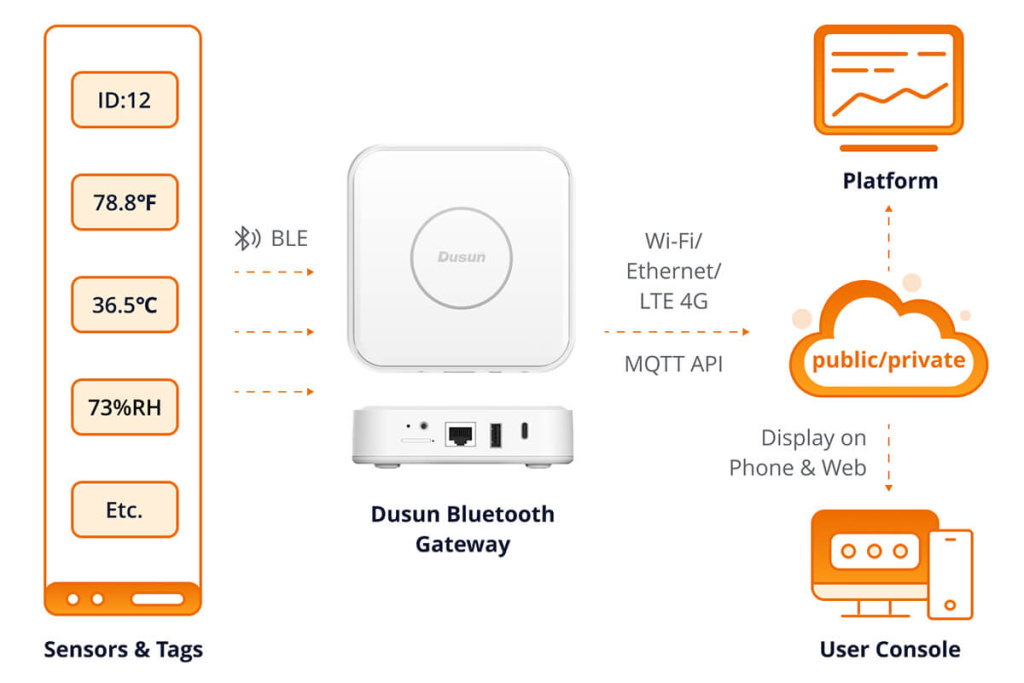What is BLE gateway?
What is a BLE gateway? A BLE gateway refers to a specialized embedded system hardware used to scan or connect to nearby BLE devices, enabling data exchange and interaction with other devices, cloud platforms, and other IoT infrastructure.
By leveraging low-powered Bluetooth Low Energy technology and other network protocols, BLE gateways act as adaptable intermediaries, closing the gap between the world of BLE devices and the wider IoT landscape. They essentially act as communication translators, converting information, data, or various forms of communications from one protocol or format to another. This ensures effective connectivity and interoperability across the IoT ecosystems and paves the way for a plethora of opportunities and innovative applications.
Functions of BLE Gateways
BLE gateways offer a diverse range of functionality and features that enhance their effectiveness in IoT deployments. Some key features include:
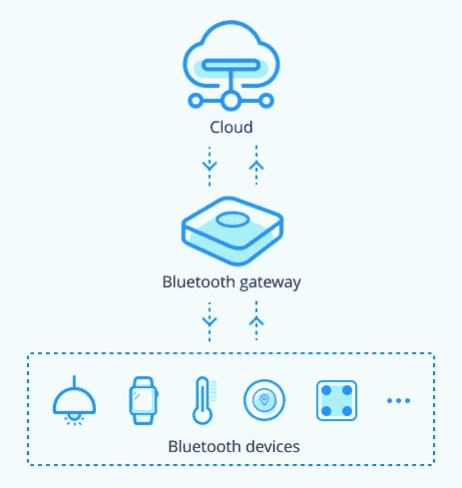
Data Aggregation
BLE gateways can act as central Bluetooth hub for multiple devices at the same time, collect data and then aggregate it. This aggregated data can be sent to remote cloud platforms or local servers for further processing and analysis in order to gain valuable insights and decision-making. By consolidating and transmitting a unified dataset rather than individual data streams, BLE gateway minimizes network congestion and maximizes data throughput.
To streamline the process of managing connected devices and aggregating data, BLE gateways are often furnished with an intuitive GUI (Gateway User Interface). Users can easily setup data aggregation settings, monitor and manage Bluetooth device connection status, and access aggregated data for analysis or visualization through this interface.
Protocol Conversion
BLE gateways can translate BLE data into other communication protocols, or vice versa. For instance, a BLE gateway can convert the data received from Bluetooth devices into MQTT or HTTP protocol, which makes it easier to integrate with cloud servers or work with other IoT systems.
The protocol conversion capability of the BLE gateways allows for interoperability across many communication protocols, which in turn increases the adaptability of BLE devices in the wider IoT ecosystem.
Data Forwarding
One of the primary functions of BLE gateways is to enable the forwarding of data collected from Bluetooth devices. It may effectively move the gathered data to the intended locations by serving as a gateway hub.
For prompt information sharing and processing, BLE gateways can, for instance, pass the data gathered from Bluetooth devices to other networks, such Wi-Fi or cellular networks.
Security Management
Security is a critical aspect of BLE gateways. BLE gateway have to implement robust security policies and mechanisms to safeguard the communication between Bluetooth devices, and protect the data transmitted between BLE devices and the cloud.
BLE SoCs often come with encryption built in. This encryption ensures that even if someone intercepts the message, they won’t be able to understand its content without the proper decryption key. On the other hand, integrated security chips—such as Trusted Platform Modules, or TPMs—can also be incorporated into BLE gateways. BLE gateway security can be further improved by include physical security features like tamper-resistant enclosures in the design. Putting authentication mechanisms like MQTT SSL into practice is also an effective way to enhance security when communicating with cloud platforms.
Types of BLE Gateways
In the world of BLE gateways, there exists a diverse range of options. In this article, we will give a thorough overview of the most prevalent kinds of BLE gateways in this post. You will acquire a comprehensive understanding of BLE gateway technology by exploring the subsequent sections, which will provide you with insightful knowledge about the many models of BLE gateways and their features.
BLE 4.2 vs BLE 5.0 Gateway
Understanding the differences and advancements between BLE 4.2 and BLE 5.0 gateways and and considering the specific needs of your IoT application will guide you in making an informed decision between BLE 4.2 and BLE 5.0 gateways.
Bluetooth has many iterations in its history. Bluetooth 4.2 was released in 2014, bring with a number of important features for IoT applications, such as the Low Energy Secure Connection with Data Packet Length Extension, Link Layer Privacy with Extended Scanner Filter Policies, and Internet Protocol Support Profile (IPSP) version 6 ready for Bluetooth Smart things to support connected home.
In 2016, Bluetooth 5.0 was released, expanding upon the capabilities of BLE 4.2. It added more features and capabilities to the table. Bluetooth 5.0 has several noteworthy characteristics, such as a longer range (up to 200 meters in open spaces and support with Bluetooth Long Range), higher data transfer speeds (up to 2 Mbps), and the ability to send larger data packets (up to 255 bytes, DLE). Later iterations of Bluetooth 5.0, including Bluetooth 5.1 and 5.2, added mesh networking capabilities, direction-finding (AoA), and other enhancements.
In recent years, BLE 5.0 gateways have become more widely available in the market, as they can be certified by the Bluetooth Qualification Body (BQB). This guarantees compliance with Bluetooth standards and interoperability with other Bluetooth devices.
General BLE Gateways vs BLE Beacon Gateways vs BLE Mesh Gateways
When it comes to BLE gateways, there are several varieties available, each serving specific use cases and offering distinctive features. Knowing the different types of BLE gateways allows you toselect the best BLE gateways for your IoT applications, ensuring optimal performance and functionality. Now, let’s explore the three main types: General BLE Gateways, BLE Beacon Gateways, and BLE Mesh Gateways.
General BLE Gateways (Long-time Connection)
The most common use case for Bluetooth technology is the long-term connection feature, like when you use your iPhone to transfer audio to your earphone. General BLE gateways are frequently used for establishing long-term connections with BLE devices. To continuously collect data, they keep a steady connection with BLE-enabled devices like temperature and humidity monitors, wall switches, smart thermostats, and pulse oximeters, etc.
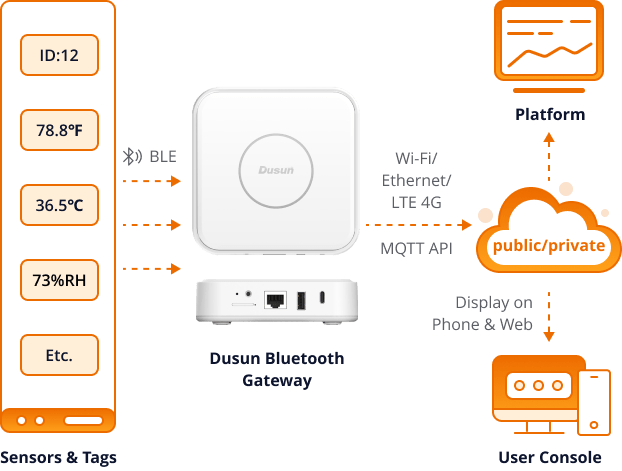
When choosing a general BLE gateway, the ability to maintain stable connection—such as data caching, reconnection, supplemental transmission, and low latency—should be given higher priority rather than the the maximum number of simultaneous connections in this case.
BLE Beacon Gateway (Some May Call It BLE Scanner Gateway)
BLE beacon gateways are specifically designed for indoor positioning applications. They scan for data packets transmitted by nearby BLE beacons and tags and send this data to designated cloud platforms.
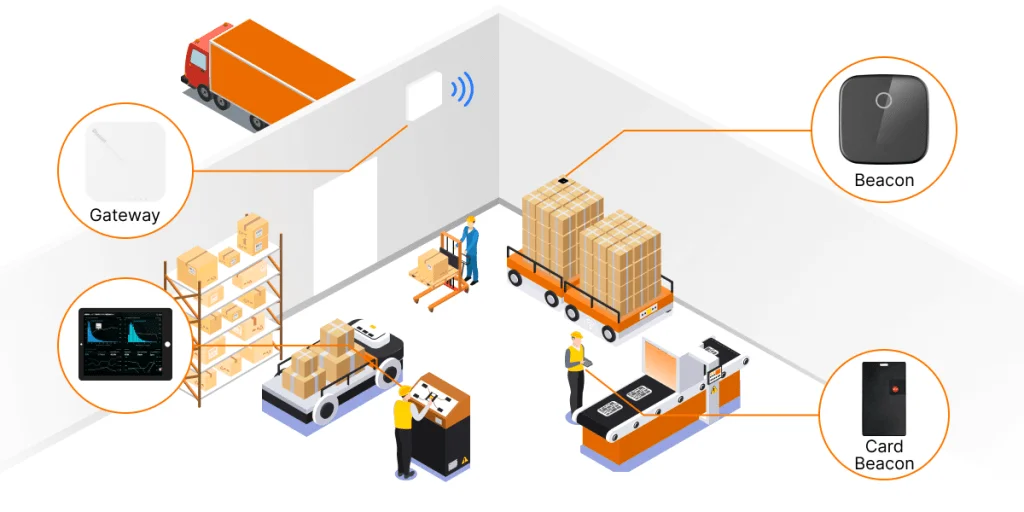
There are two types of BLE beacon gateways:
a. BLE gateway using RSSI Positioning:
These gateways use Bluetooth signal strength (RSSI) for positioning. They work well in situations where it’s enough to know an object or device is there within a room. They provide a general indication of proximity, without precise position.
b. BLE gateway employing AoA Positioning:
BLE gateways utilizeing AoA technology and are often equipped with a 4×4 antenna array. Such AoA-based positioning delivers a better level of accuracy for indoor posotioning applications.
At Dusun IoT, we offer customized ultra-convergence positioning solutions that combine various positioning technologies to satisfy certain application needs. Feel free to consult.
BLE Mesh Gateway
Similar to Zigbee mesh networks, BLE mesh technology allows the construction of scalable and energy-efficient networks of BLE devices. This technology is particularly useful for IoT lighting control and building automation applications. BLE mesh provides reliable performance, high scalability, and enhanced security.
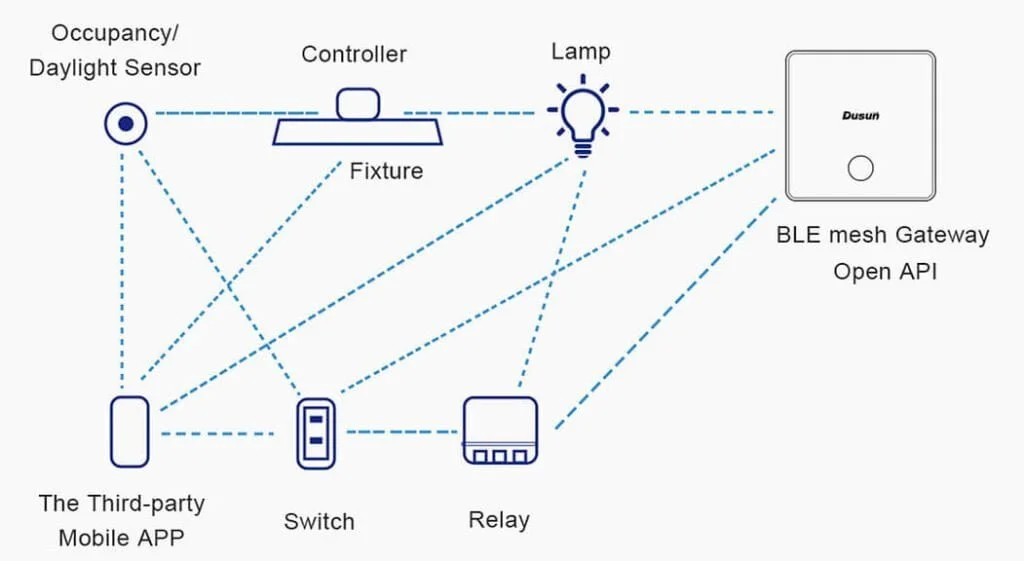
At Dusun IoT, we offer a comprehensive range of BLE mesh lighting control components, including drivers, switches, sensors, and gateway-based lighting controllers. With our BLE mesh gateways, you can create IoT lighting control devices that are customized to your customers’ unique requirements and come in a range of complexity levels. We have successfully implemented BLE mesh gateways in numerous factory lighting control solutions. For further details, feel free to look at our case study on LED grow light controllers for greenhouses.
Wireless vs Wired BLE Gateways
Additionally, there are a few wireless and wired connectivity choices that can improve the BLE gateway’s adaptability for a range of IoT applications. Businesses and developers may fully unlock the potential of their IoT solutions and produce inventive, connected experiences by using these options. Let’s explore some of these options.
Wireless BLE Gateways
BLE WiFi Gateways
A BLE WiFi gateway, also known as a BLE to WiFi gateway, is a wireless device that combines BLE and WiFi technologies. It makes data exchange, remote monitoring, access, control, and other IoT functions possible by enabling BLE devices to connect to cloud platforms and apps over WiFi networks.
When selecting a BLE WiFi gateway, there are a few considerations to keep in mind. One choice for BLE WiFi gateways is to go with devices based on the ESP32 SoC, which combines Bluetooth and WiFi connectivity and does away with the need for separate WiFi modules. This is a reasonably priced option.
It’s also necessary to take into account the BLE WiFi gateway’s WiFi capabilities. You can look for features like support for 2.4GHz and 5GHz WiFi frequency bands or the support for both bands. This makes it possible to be compatible with many WiFi networks and guarantees the optimal connectivity.
BLE Cellular Gateways
A BLE cellular gateway integrates BLE technology with cellular connectivity, such as 4G LTE or 5G, to BLE devices to communicate over cellular networks. This type of gateways provide wide-area coverage and facilitate IoT applications in remote or mobile settings where WiFi or Ethernet networks may not be feasible or available.
BLE cellular gateways typically include cellular modules, such as 4G/5G LTE or NB-IoT modules, which allow the gateway to establish connections with cellular networks. These gateways often have one or more slots to insert SIM cards, enabling the gateway to setup stable connections with cellular networks. Some BLE cellular gateways may also incorporate GPS antennas for location tracking purposes.
Unlike BLE WiFi gateways that are generally stationary, BLE cellular gateways offer mobility. For example, DSGW-340 BLE cellular gateway is a portable device that combines both WiFi and Cellular LTE connectivity. It can be utilized in facilities that have WiFi coverage and brought outside where cellular service is available. This mobility makes BLE cellular gateways suitable for applications that users must take the gateway with them, such as elderly health monitoring and remote patient monitoring.
BLE LoRa Gateways
A BLE LoRa gateway combines low-powered BLE and LoRa (Long Range ) technologies to allow BLE devices to connect to LoRa networks. LoRa is a wide-area network technology that provides long-range communication with low data rates. BLE LoRa gateways can improves the range and coverage of IoT deployments, making it an ideal solution for applications such as personnel and asset location tracking and environmental parameter monitoring in large buildings.
One typical use case for BLE LoRa gateways is smart apartment property management. In a large building, numerous BLE beacons with temperature and humidity detection capabilities are strategically placed throughout the premises. These beacons transmit their data, which is then scanned and captured by BLE cards deployed in the vicinity. After that, the BLE cards then relay this information to a BLE LoRa gateway, which sends the gathered information to the application platform for further processing and analysis.
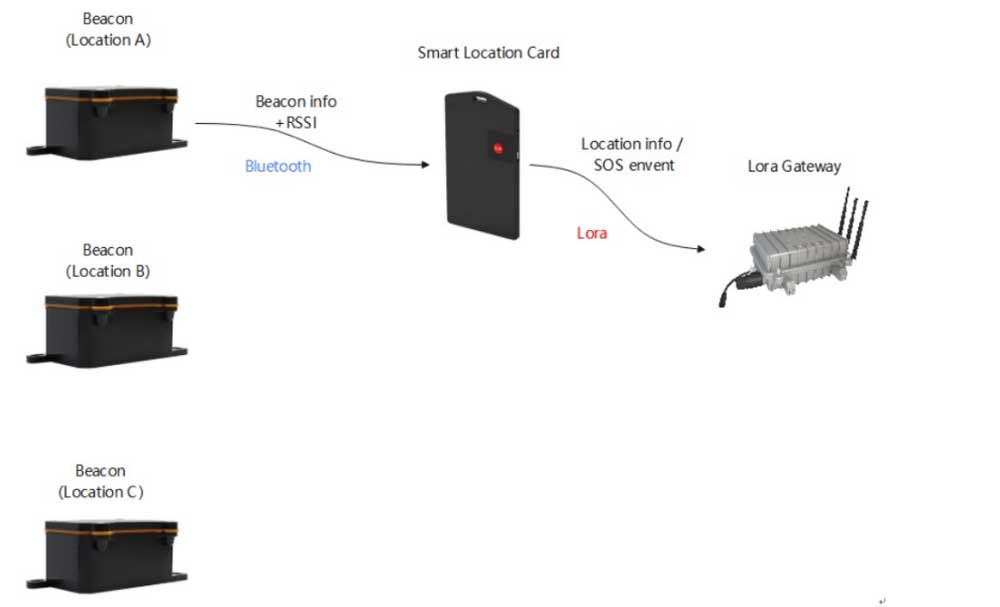
First off, it lowers the total cost of devices by enabling a building to use a single LoRa gateway device in addition to multiple affordable BLE beacons and cards. Second, there is no need for extensive wiring installations because all of the deployed devices may run on batteries because they are all powered by low-power wireless technology. This simplifies and improves the convenience of the installation and maintenance process.
BLE Zigbee Gateways
Unlike previous BLE gateways that convert BLE data into other protocols, BLE Zigbee gateways offer an advanced solution for a connected smart home ecosystem. It enhances the automation and control possibilities within a smart home environment by integrating BLE and Zigbee technologies.
For example, Roombanker’s Home Security Hub serves as the central brain of its security alarm and home automation system. This hub supports multiple wireless protocols, including Zigbee, BLE, and RBF, allowing it to connect with up to 128 wireless peripheral devices. This rich integration within the hub enables multi-scene interactions including but not limited to home environmental monitoring, intruder detection, and energy management in a variety of settings such as smart apartments, villas, and small shops.
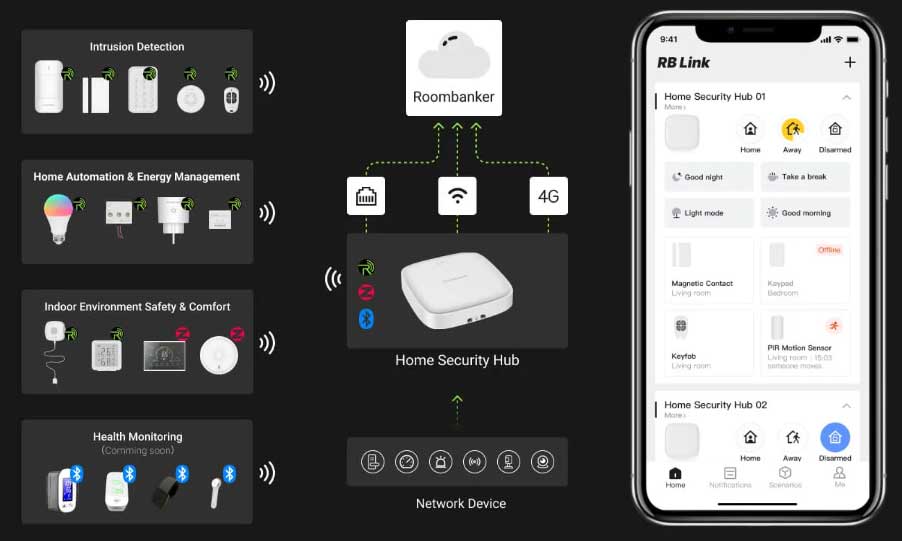
Wired BLE Gateways
BLE Ethernet Gateways
BLE Ethernet gateways provide a means for BLE devices to connect to wired Ethernet networks. These gateways are made to provide a dependable and secure connection for Internet of Things applications that need a solid network infrastructure, low latency, and fast data transfer. They are commonly utilized in industrial IoT deployments, smart buildings, and other scenarios where wired connectivity is required or preferred.
The availability of Power over Ethernet (PoE) settings is a noteworthy factor to take into account while choosing BLE Ethernet gateways. By allowing data and power to be transferred over a single Ethernet cable, PoE makes installations easier and eliminates the need for extra power sources. IoT deployments can take advantage of reduced installs and streamlined connectivity by employing BLE PoE gateways.
Buy, Custom or Build Your Own BLE Gateways?
The choice of whether to purchase, have a custom built, or construct your own BLE gateway is influenced by a number of variables, such as your needs, financial budget, time to market, technical complexity, scalability, and ongoing support. You have to evaluate the trade-offs between creating a custom solution and using already-available off-the-shelf choices. Here are some considerations to think about for each option:
Purchase From a Reputable Vendor
Buying a pre-built BLE gateway from a reliable supplier tends to be the simplest and fastest choice. It enables you to take use of tried-and-true solutions that are already in place. If your needs match those of the readily available off-the-shelf choices and you want a plug-and-play solution without having to commit a lot of time or money to development, this is a good option.
The BLE gateways from Dusun IoT offer an open API for integrating different BLE devices, giving you flexibility and interoperability with a lot of different IoT applications. The well-known American electrical wholesaler DigiKey, with its headquarters in Minnesota, is now selling these gateways. Since buying from Digikey does not require lead time, this is a convenient and reliable choice.
Custom Build
If off-the-shelf options don’t satisfy your precise requirements, a custom-built BLE gateway like the Dusun Pi can provide you the flexibility to customize the gateway to meet your exact specifications.
The performance capabilities of Dusun Pi BLE gateways are comparable to those of many Raspberry Pi models, offering a variety of alternatives. This lets you choose a BLE gateway based on features like memory, processing speed, operating systems, connectivity, and other attributes that meet your needs. You have more control over the features (e.g. Android BLE gateway) and functionalities (e.g. adding or removing a Li-battery backup.) of the gateway as needed.
You can also work with a Dusun development team to modify the Dusun Pi BLE gateway’s firmware and software to add particular features or integrations that aren’t easily found in off-the-shelf products. This degree of personalization guarantees that the BLE gateways satisfy your particular needs and blend in well with your IoT ecosystem.
Build Your Own
Building your own BLE gateway involves developing the hardware and software from scratch. This option requires a high level of technical expertise, resources, and time commitment. It may be suitable if you have unique requirements, complete control over the design, or if you have a team with the necessary skills and experience to develop a custom solution.
Dusun IoT offers a wide range of System on Modules, wireless BLE modules for you to choose. As this is a complex and time-consuming process, we can assist in careful planning, prototyping, testing, and ongoing maintenance.
It is true that creating your own BLE gateway from scratch is difficult and time-consuming task, and demands a high level of technical know-how and resources. Building a custom solution, however, can be a good choice if you have specific requirements, total control over the design, or a team with the required knowledge and expertise.
Dusun IoT’s offering of System on Modules, wireless BLE modules and development kits can be beneficial in the process of building a custom BLE gateway. SoMs offer a pre-made platform that can expedite the process of development. A wide range of modules from Silicon Labs and Nordic allow you to incorporate wireless BLE connectivity into custom gateway design. You may begin developing BLE gateway more quickly with the help of our BLE gateway development kits.
Working with Dusun IoT can acquire the essential direction and assistance during the development process, assisting in the reduction of obstacles and guaranteeing a satisfactory result. We can help with meticulous planning, ensuring that your requirements are clearly defined and translated into an effective hardware and software design Mwanwhile, validating the functionality and performance of the custom-built BLE gateway requires testing and prototyping, for which Dusun IoT may offer support and expertise. Ongoing maintenance and support can also be quite important, partnering with Dusun IoT can guarantee that you have access to technical help and upgrades whenever needed.
Final Words
BLE gateways play a crucial role in enabling seamless communication and connectivity between Bluetooth devices and the broader IoT ecosystem. This article makes an in-depth exploration on what is BLE gateway, its functions, and different features of BLE gateway including BLE versions, attributes specific to certain IoT applications, and lists of wireless and wired BLE gateways. It attempts to provide a thorough how-to for people looking to find the best BLE gateway solution for their particular needs and use cases.
Whether you choose to buy a pre-built solution, opt for a custom build, or embark on building your own BLE gateway, Dusun IoT offers a wide variety of BLE gateway solutions with different specifications. For readers who are interested in exploring BLE gateways further, please visit Dusun IoT’s Bluetooth gateway page to find the right BLE gateway solution and prices. And don’t hesitate to contact our staff if you need any additional information or help.









